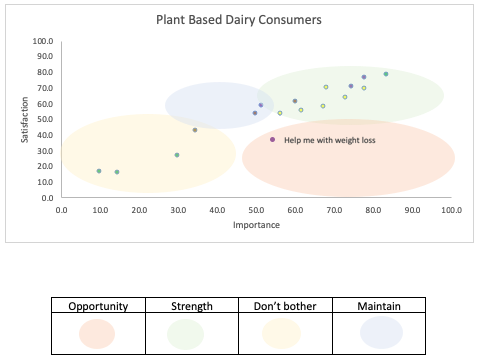Unlocking Consumer Decisions: The power of Jobs-to-be-Done Studies in Market Research
Understanding consumer preferences and choices is a key for companies to grow in a competitive landscape. Methodologies such as segmentation and brand equity studies typically served as the go-to tools to gain insights into consumer preferences. An alternative approach to understanding consumer decisions involves conducting a Jobs-to-be-Done (JTBD) study. This method explores how consumers make purchasing decisions by examining their motivations, specifically focusing on the job they want a product or service to fulfill.
The History of the Jobs-To-Be-Done Framework
The JTBD framework has its roots in a few key ideas from economics, innovation, and marketing - but really gathered a larger following in the 1990’s and 2000’s. The concept is often associated with Harvard Business School professor Clayton Christensen. He introduced JTBD in the context of disruptive innovation, explaining why customers “hire” products or services to get specific “jobs” done. This perspective focuses on the customers’ problems as an opportunity for innovation.
It started as a way to think about product development and business strategy differently. Instead of demographic or product/features focused strategies, JTBD suggests companies should look at the needs that arise in people’s lives and create products that perform a job that addresses these needs.
Early versions of the JTBD theory can be seen in Theodore Levitt’s famous quote that “People don’t want to buy a quarter inch drill. They want a quarter inch hole!” This shift towards the purpose of the product, rather than the product’s features, laid the groundwork for the JTBD approach.
As a formal methodology, JTBD has been modified over the years and is now applied across nearly every industry. It’s influenced design thinking, startup methodologies, approaches to marketing, and is a staple in innovation. The core idea has stood the test of time because of its natural simplicity and focus on understanding the customer’s perspective, which is essential for successful product development and marketing. These JTBD studies are often used to complement existing research (such as segmentation or brand equity studies) by providing more insights into how consumers make decisions.
How JTBD studies are Conducted
Conducting Jobs-to-be-Done studies involves a few methodical steps to deeply understand customer motivations and to uncover insights that drive innovation and product development. Here's a breakdown of how these studies are typically carried out:
Defining the Job(s): This is the foundational step where you pinpoint the task a customer is trying to achieve in a given situation. It's not about the product; it's about understanding the 'job' - what the customer is ultimately trying to accomplish. For instance, the decision to opt for plant-based food alternatives may be driven by the "job" of being healthy without taking medications. In this scenario, the consumer essentially "hires" the plant-based food alternative to fulfill that specific job.
Identifying the Job Executor: Determine who is actually doing the job. It's important to note that the person who buys the product isn't always the one who uses it.
Uncovering the Job Context: Context is everything in JTBD. You need to understand when and where the job is being done, under what circumstances, and what constraints are influencing the job executor. To build on the earlier example, a consumer might opt for plant-based food alternatives to address the "job" of being healthier. While this may seem straightforward in context, the concept of "healthier" encompasses various factors, such as assistance with weight loss, lowering cholesterol, reducing blood pressure, and more. Each of these aspects contributes to the overarching "job" of being healthier.
Conducting Qualitative Research: One-on-one interviews are a common method used to dive deep into the customer's experiences. You ask about the last time they 'hired' a product or service for the job you’re investigating. Storytelling is a crucial part of this process because it reveals the subtleties behind their actions and decisions.
Job Mapping: This is about breaking down the job into specific steps the customer goes through. It helps to identify every stage of the job, from start to finish, including any emotional states or pain points the customer may experience.
Identifying Pain Points and Unmet Needs: Through the mapping process, you can pinpoint where customers face difficulties or where current solutions fall short. These are the areas ripe for innovation.
Prioritizing Opportunities: Not all unmet needs are created equal. Some are more critical to the customer than others. By understanding the importance and current level of satisfaction of each part of the job, you can prioritize which unmet needs represent the biggest opportunities.
Quantitative Validation: After the qualitative research, a larger-scale survey can validate which jobs and unmet needs are most important and least satisfied across the market. This step often uses statistical methods to ensure the findings are robust and predictive.
Solution Ideation and Development: With a clear understanding of the jobs and unmet needs, you brainstorm and develop solutions that will do the job better than existing products.
Iteration and Feedback: This involves testing your solutions with customers to ensure they are effectively getting the job done. This is a cyclical process that refines the solution until it meets the job requirements satisfactorily.
Market Testing and Launch: Before a full launch, it's common to test the new product or service in a smaller, controlled environment to refine the marketing message and delivery mechanisms.
Throughout this process, the focus remains steadfastly on the customer’s perspective, ensuring that the end solution is truly aligned with what the customer is trying to achieve. It's this dedication to understanding the 'why' behind customer behavior that makes JTBD studies such a powerful tool for innovation.
Lab42’s Example of the JTBD Framework
To show a real-world example of the JTBD framework, we conducted a study to understand why people choose plant-based foods and to identify where there might be room for new market opportunities. While the study included various groups of plant-based consumers, this analysis specifically focuses only on those that frequently consume plant-based dairy alternatives.
Audience Specs:
Sample size: N=1,000
US National
Aged 18+
Must have purchased plant-based food (plant-based meat or plant-based dairy) within the past six months
Must consumer plant-based foods once a month or more often
Calculations:
Opportunity= Importance T2B + (Importance T2B - Satisfaction T2B)
Importance T2B accounts for Very important / Somewhat important
Satisfaction T2B accounts for Very satisfied / Somewhat satisfied
To illustrate how the opportunity score is calculated, the data below shows three examples of calculations for those who only consumer plant-based dairy alternatives.
Map
Findings From the results
Our analysis revealed that consumers think of this category very functionally and almost not at all emotionally. They primarily hire plant-based dairy (PBD) alternatives to address functional “jobs” to improve their health; specifically, to improve gut health, reduce the risk of heart disease, and lower cholesterol. The secondary job of PBD focuses on the fulfillment of dietary needs. Conversely, PBD is less likely to be chosen for emotional jobs, such as boosting confidence, attractiveness, or fostering a sense of belonging to a like-minded community.
Existing plant-based dairy (PBD) products generally do a good job in fulfilling consumer needs. However, an area for improvement lies in assisting PBD consumers with weight loss—a crucial yet currently unsatisfying aspect. This insight implies that innovation geared towards aiding consumers in weight loss could attract a specific subset of PBD consumers. It also suggests that products in the plant-based dairy market might not currently provide this benefit and could gain market share through innovative product development.
Another area of potential opportunity is enhancing the emotional connection consumers have with these products and the category as a whole. Our research reveals that consumers hire PBD products for mostly functional reasons. Though emotional reasons did not seem that important to them based on our survey, a category would certainly benefit if consumers realized and bought these brands for emotional reasons.
Research Post-Mortem Findings
As this was one of our first forays into implementing the JTBD framework in a study, we had several additional learnings outside of what the data told us. For example, going forward, we will avoid defining the audience too narrowly. In the study, we focused solely on frequent consumers of plant-based foods, assuming they were most likely to be heavy and loyal consumers. However, we did not include lapsed or potential customers - those open to trying plant based foods. Surveying a broader audience could have enabled us to better understand what “jobs” may have left some consumers unsatisfied, and in turn revealing more areas of opportunity.
Another step we did not include in this study was the qualitative research aspect. This step would have allowed us to dig deeper into the jobs consumers hire brands to do, and their motivations could have identified even more jobs we could have included in the study.
The Jobs-to-Be-Done framework offers a specific lens through which companies can better understand consumer behavior and the underlying motivations for their purchasing decisions. This approach goes beyond traditional market segmentation by not just looking at who the consumer is, but also at what they are trying to achieve with the products and services they “hire.”
Our study into plant-based dairy alternatives illustrates how functional needs, such as health improvements and dietary requirements, are primary drivers for consumer choices in this category. The untapped potential in creating emotional resonance with consumers represents a valuable opportunity for brands.
While current plant-based dairy options satisfy functional jobs effectively, they fall short in assisting with weight loss and establishing an emotional connection. Brands that can innovate and fill these gaps, addressing both the unmet functional need for weight management and the less acknowledged but equally important emotional jobs, could differentiate themselves and capture additional market share.
Moving forward, the power of JTBD studies lies in their ability to uncover these deeper insights, guiding companies to not only innovate but also to connect with consumers on a level that aligns with their core needs and aspirations.



